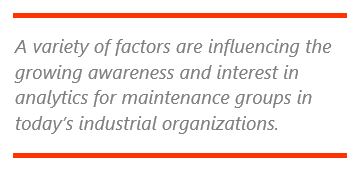Overview
A variety of factors are influencing the growing awareness and interest in analytics by maintenance groups. Today’s industrial organizations see the value that effective data management, KPIs, and Analytics in EAM  can bring. “After-the-fact” reports based on historic information alone are no longer adequate. To compete effectively in today’s hyper-competitive industrial environments, organizations need to provide users with actionable, real-time (or near-real-time) information.
can bring. “After-the-fact” reports based on historic information alone are no longer adequate. To compete effectively in today’s hyper-competitive industrial environments, organizations need to provide users with actionable, real-time (or near-real-time) information.
This is particularly true for the maintenance groups tasked with keeping a company’s manufacturing assets available and performant. As a result, analytics are becoming critical for effective enterprise asset management.
Why Analytics in EAM? Why Now?
Today’s maintenance organizations have access to much foundational data. These include asset data, labor data, and job plan information, preventive and corrective maintenance scheduling, and sensor-based condition monitoring data. All these data, whether structured from relational databases or data warehouses; or unstructured, text-based information found in work requests, work orders, e-mail messages, or other forms must be mined, evaluated, and analyzed.
While, in the past, analytics were the sole domain of corporate data scientists, many of today’s newer analytics solutions were designed for use by plant-level maintenance and operations staffs. This has helped “democratize” analytics to a large degree, making these solutions much more accessible.
Common Analytics Categories
Analytics come in a wide variety of categories and variations. They can range from views of historic data to data mining and analyses of connected, real-time, and near-real-time information. Examples of common analytics categories include:
- Descriptive statistics are widely used in business today to describe and analyze historical data and identify trends. Examples include analyses that use mean, median, and mode, central tendency, variation, and standard deviations to describe data.
- Predictive analytics provides insight into probability and what will likely occur next. It often includes running of hundreds or thousands of models to identify the most likely and/or optimum scenarios.
- Prescriptive analytics moves beyond predicting what will happen to what should be done. It offers information on optimal decisions based on predictions of future conditions. Prescriptive analytics often uses both structured and unstructured data, to analyze the context of the underlying data and suggest optimum solutions.
KPIs Can Be an "On Ramp" for Analytics Solutions
For many maintenance organizations, existing KPIs are a good foundation for areas that may need deeper analysis. Combined with analytics, maintenance KPIs can provide even greater visibility into asset condition and health.
Examples can include line and machine uptime, equipment availability, maintenance costs vs. budgets, labor costs and hours vs. budget, preventive maintenance performance summaries, overall maintenance quality, and the percentage of unplanned and emergency work. Other KPIs can include such measures as mean-time-to-failure (MTTF), mean-time-to-repair (MTTR), equipment downtime statistics, and overall equipment effectiveness (OEE).
Recommendations
Based on ARC research and analysis, we recommend the following actions for technology users and suppliers, respectively.
Recommendations for technology users:
- Understand that proper data organization and structure in providing timely and actionable data and the ability to make predictions about needed actions are critical to the success of today’s maintenance organizations.
- Maintenance users should assess the ability of their systems to work with adjacent systems and analyze asset and labor information from EAM systems, equipment health from sensors and condition monitoring solutions, and ensure that their integration and native interoperability are in place to be able to share, and analyze, key data elements.
- Make analytics a priority as part of a maintenance strategy to be able to capture and identify performance trends and predict needed and suggested preventive and corrective maintenance activities.
Recommendations for technology suppliers:
- Continual improvements in feature and functionality is important, but identifying the core value proposition for EAM systems is critical to ensuring that such systems can best quantify investment returns for customers.
- Offering integration and/or native interoperability capabilities as well as open APIs (application program interface) and highly configurable SDKs (software development kits) can help ensure customers’ EAM systems can work well across organizational systems.
- Offering consulting services to tailor base functionality or to customize solutions for customers can provide critical differentiation in today’s crowded solution marketplace.
ARC Advisory Group clients can view the complete report at ARC Client Portal
If you would like to buy this report or obtain information about how to become a client, please Contact Us
Keywords: Descriptive Analytics, Predictive Analytics, Key Performance Indicators (KPIs), Business Intelligence (BI), Enterprise Asset Management (EAM), ARC Advisory Group.




